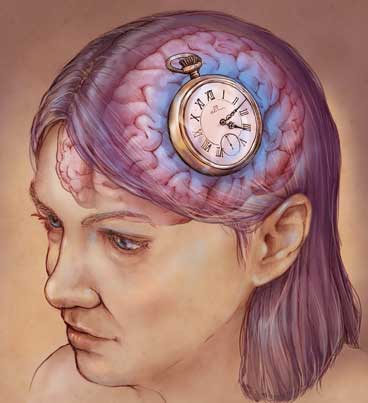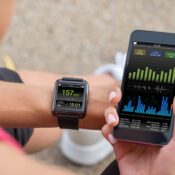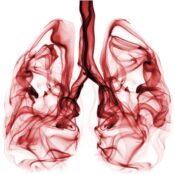In neurology, there is a number that commands attention—32,000. That’s the number of brain cells that die per second after a stroke, or “brain attack”— precious cells that help you talk to your friends, climb the stairs, button your shirt, swallow your coffee. What would it feel like to suddenly lose even a small portion of them?
Mark McEwen, former TV weatherman for The Early Show on CBS, found out during a flight to Orlando in 2005. He had been dozing, then woke up, feeling odd. “It was like being underwater and trying to swim to the surface,” says McEwen, now 55. “You’re just trying to survive, to make sense of something that is senseless.” He had no clue it was a stroke. Nor apparently did the attendant who helped him off the plane—or the skycap who left McEwen sitting curbside in a wheelchair. McEwen could barely talk, but he did manage to ring his wife’s cell phone and convey a basic message. “Help me. Not good.”
If someone near you, like McEwen, were having a stroke, would you recognize it? Would you know what to do? Stroke is the third leading cause of death in this country—and every 40 seconds on average, someone in the United States suffers one. About 30 percent of strokes are mild, resulting in no disability. But the 20 percent that are severe, yet survivable, can be crippling.
“A major stroke can change everything—the ability to speak, to move, to work,” says Dr. Walter Kernan, professor of medicine at Yale University School of Medicine. “It may seem to rob a person of his life without actually taking it.” Fortunately, new therapies are in the works that may help improve outcomes.
Striking Out Against Stroke
The most significant advance is the clot-busting drug, known as tissue plasminogen activator, or tPA, which can help the 85 percent of patients whose strokes are caused by clots in the brain. “Sadly,” says Dr. Ralph Sacco, a neurologist and president-elect of the American Heart Association (of which the American Stroke Association is a division), “only about 5 percent of patients actually get it because they don’t reach the hospital in time or they don’t go to a [hospital certified as a] primary stroke center, which can give it rapidly.” Administered intravenously, it takes time to dissolve a clot, particularly a large one and as neurologists say, “time is brain.” Last year, the AHA revised its guidelines, saying that tPA could be given up to four hours and 30 minutes after the onset of stroke—a significant increase over the previous three-hour window. But sooner remains better.
“The best outcomes are still in patients with small clots who receive tPA in less than 90 minutes,” says Dr. Rishi Gupta of Vanderbilt University Medical Center.
Other technologies are already available at comprehensive stroke centers (a notch above primary stroke centers, which are mainly geared to giving tPA). At the Cleveland Clinic, doctors are using stents to prop open blocked blood vessels during a stroke, as well as two FDA-approved devices to help remove clots. One, the Merci Retriever, works like a miniature corkscrew to pull the clot out. The other, the Penumbra, breaks up a clot with microjets of water, then suctions out the pieces. Both devices require highly skilled specialists, and not every patient is a candidate. “You have to image the brain first to see if functional tissue remains that could benefit from restored blood flow,” says Dr. Irene Katzan, medical director of the stroke program at the Cleveland Clinic.
Refining Recovery
Acute treatment is only the first step in stroke recovery. Fortunately, therapists are getting better results with post-stroke rehabilitation than ever. “We used to say to patients, ‘you have three to six months to improve, and after that you can’t expect a whole lot,’ ” says Dr. Richard Zorowitz, chair of physical medicine and rehabilitation at Johns Hopkins Bayview Medical Center. Now, knowledge about the brain’s ability to rewire itself—a concept called neuroplasticity—has encouraged therapists (and patients) to try longer and harder.
“Thanks to the neuroplasticity of the brain—the ability of the brain cells to rearrange their connections, our brain has more capacity than we ever imagined to rewire itself for greater levels of recovery,” says researcher and stroke survivor Dr. Jill Bolte Taylor (read “Life After Stroke”).
Dr. Steven C. Cramer at the University of California, Irvine, is working with robotic therapy to help restore function as well as investigating two hormones that may encourage stem cells to develop into new neurons, key cells that transmit nerve signals to and from the brain. So far, early results look promising. Meanwhile, Dr. David Simpson at Mount Sinai School of Medicine in New York is using botulinum toxin (Botox) to help reduce the spasms that lead to twisted limbs and abnormal gaits, a frequent result of stroke.
For the most part, rehab consists of hard work—and lots of it. Three hours a day is the rule of thumb. But technologies like Nintendo’s Wii video game console keeps exercises interesting—engaging stroke patients in games such as bowling or tennis to improve balance and shifting of weight.
As for McEwen, he’s back on his feet after 14 months of rehab. Today the former weatherman, who described his experiences in his 2008 book Change in the Weather, is a motivational speaker and spokesperson for the American Stroke Association. The organization’s latest campaign (PowerToEndStroke.org) is directed at people with risk factors for stroke—high blood pressure, diabetes, excess weight, and a history of heart disease. “There are lots of things you can do to lower your risk for stroke,” says McEwen. “Knowledge is power.” And it could just save your life.
Boosting tPA
Many researchers are hard at work on therapies that can be used with tPA—an intravenous treatment for ischemic stoke—to boost its effectiveness. One of the most promising is ultrasound. As with many discoveries, the benefits were discovered accidentally. Dr. Andrei Alexandrov, director of the Comprehensive Stroke Center at the University of Alabama at Birmingham, was using a portable ultrasound device to examine patients’ brains during treatment. He wanted to determine how long tPA took to fully dissolve clots. A nurse observed that patients seemed better whenever he showed up with his machine. Half a dozen randomized trials have shown that gentle pulses of ultrasound help move tPA-rich blood to and through the clot, doubling the chances of clearing the blood vessel in two hours. Unfortunately, most hospitals do not have the necessary transcranial ultrasound machines or the sonographers to run them. But Dr. Alexandrov, together with a Seattle-based start-up called Cerevast, is developing a simple, relatively inexpensive device that any ER staffer could operate.
Become a Saturday Evening Post member and enjoy unlimited access. Subscribe now




Comments
Too much sodium has long been connected with the risk of high blood pressure, which is a major risk factor for stroke.
I need an orientation about robotic therapy. I have a daughter with 18 yrs. status post ICH. I want to give her all opportunities for rehabilitation. Any suggestions?